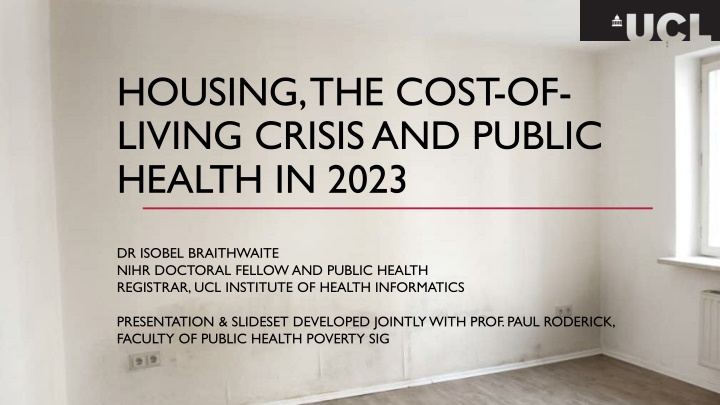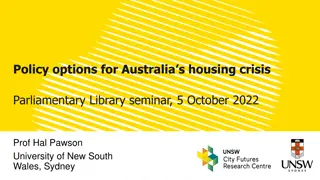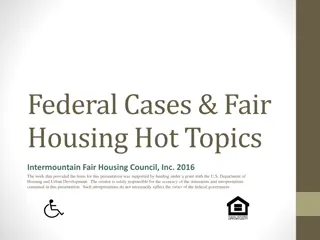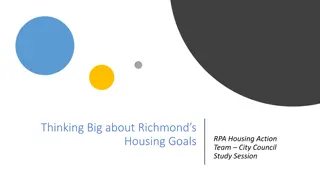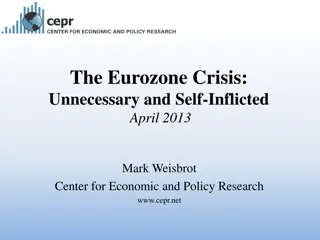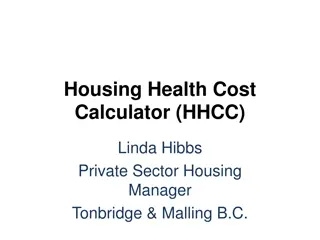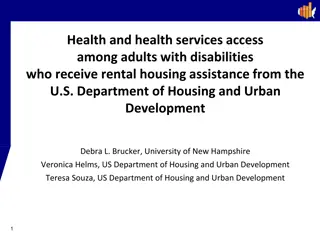The Impact of Housing Policies on Public Health and Cost of Living Crisis
Dr. Isobel Braithwaite's presentation delves into the historical context of housing policies, from post-WW2 initiatives to the current challenges in housing affordability and the cost-of-living crisis. The discussion includes the evolution of social housing, the Right to Buy scheme, and the financialization of the housing sector. Insights highlight how these policies have shaped housing landscapes and influenced public health outcomes.
Download Presentation

Please find below an Image/Link to download the presentation.
The content on the website is provided AS IS for your information and personal use only. It may not be sold, licensed, or shared on other websites without obtaining consent from the author.If you encounter any issues during the download, it is possible that the publisher has removed the file from their server.
You are allowed to download the files provided on this website for personal or commercial use, subject to the condition that they are used lawfully. All files are the property of their respective owners.
The content on the website is provided AS IS for your information and personal use only. It may not be sold, licensed, or shared on other websites without obtaining consent from the author.
E N D
Presentation Transcript
HOUSING, THE COST-OF- LIVING CRISIS AND PUBLIC HEALTH IN 2023 DR ISOBEL BRAITHWAITE NIHR DOCTORAL FELLOW AND PUBLIC HEALTH REGISTRAR, UCL INSTITUTE OF HEALTH INFORMATICS PRESENTATION & SLIDESET DEVELOPED JOINTLY WITH PROF. PAUL RODERICK, FACULTY OF PUBLIC HEALTH POVERTY SIG
STATEMENT OF INTERESTS No interests to disclose. PhD research funded by NIHR (Fellowship no. 302316)
HOMES FIT FOR HEROES & POST-WW2 HOUSING Post WW1 demand - the 1919 Act - often known as the Addison Act , after Addison, the Minister of Health, made housing a national responsibility: LAs were given the task of developing new homes and rental accommodation where needed by working people. Housing Act of 1930 obliged local councils to clear all remaining slum housing, and provided further subsidies to re-house inhabitants -> building of 700,000 new homes. When Aneurin Bevan became a Minister in 1945, it was as Minister for Health and Housing. The 1949 Housing Act removed the restriction of public housing to the working classes so that council housing was available to all. He insisted on good design, increased space standards and the provision of an upstairs and downstairs W.C.
RIGHT TO BUY & HOUSING SECTOR DEREGULATION Introduced by Margaret Thatcher s government through the Housing Act 1980. This also deregulated private tenancies, encouraging increasing financialisation of the housing sector. Allows council tenants to purchase their homes at up to 116,200 cheaper in London and 87,200 elsewhere (& Housing Association tenants can use a smaller discount Right to Acquire). Over 40% of homes bought through right to buy are now rented out privately (with the rents paid through state funding representing very poor value for money). Indirect effects include disincentivising the building of new social homes by councils (since RTB reduces their potential for future rental income and means that they would not receive the full sale receipt if they were sold). Ended in Scotland since August 2016 andWales since January 2019. In Scotland, this was estimated to have kept 15,500 homes in the social rented sector for future generations in just the first 4 years, and from 2017-21, Scotland delivered over 9x more social-rented homes per capita than England.
SOCIAL HOUSING AND FINANCIALISATION NEF = New Economics Foundation
Tenure for adults and children, 1994/5 - 17/8 Adults Children Image from: Bailey (2020) Poverty and the re-growth of private renting in the UK, 1994-2018 Data source: FRS/HBAI data. (Financial years)
WHICH ASPECTS OF HOUSING MATTER MOST FOR PUBLIC HEALTH? Health Foundation classification: Affordability (ability to meet direct and indirect housing costs) links closely to overcrowding Quality (e.g. thermal, damp/mould, indoor AQ, safety, falls risks) N.B. cold, energy inefficient homes also affect affordability through energy bills Stability and security Homelessness
HOUSING COSTS ARE (BECOMING INCREASINGLY) UNAFFORDABLE, AND DRIVING POVERTY
LACK OF AFFORDABILITY DRIVES RISING RATES OF OVERCROWDING Large increases in overcrowding in both social and privately rented tenures, putting both mental and physical health at risk.
QUALITY: HOME INSULATION, COLD AND DAMP Poorly-insulated housing is a key driver of fuel poverty and of cold homes and damp. Damp affects over 900,000 homes, and 653,000 had a Category 1 Hazard of excess cold in England (English Housing Survey 2021 estimates). Source: Tado The UK s homes are among the worst insulated in Europe, with average heat loss of 3 C in 5 hours compared to 0.9 C in Norway. Annual retrofit installations plummeted following withdrawal of Government support in 2012 (CCC) Source: CCC
QUALITY & SAFETY - CONTINUED In 2021 the English Housing Survey estimated that, 23% of private rental sector homes did not meet the Decent Homes Standard vs. 13% of owner-occupied & 10% of social-rented homes. The % of people exposed to hazards such as cold, damp and mould is highest in low- income and minoritised groups.
& THESE ISSUES ARE AFFECTING YOUNG PEOPLE AND MINORITISED GROUPS MOST ACUTELY
HOUSING STABILITY & TENURE SECURITY Housing stability is critical for health and home moves can adversely impact healthcare, education, social support (inc. access to childcare) & much more. It is worse in the private rented sector: 1 in 5 children in the private rented sector had moved three or more times by the age of 14 years, compared to 9% in social rented and 3% in owner-occupied homes. 26% of parents who moved three or more times rated their health as less than good, compared to 14% who did not move. The Government has proposed to end Section 21 (no-fault) evictions in its Renters Reform Bill and White Paper, which is a positive step, but how this will play out in practice is not yet clear.
RISING RATES OF ALL TYPES OF HOMELESSNESS (INC. LIVING IN TEMPORARY ACCOMMODATION) At least 271,000 people are officially recorded as homeless in England, inc. >120,000 children. 250,000 of those are housed in expensive and unstable temporary accommodation by 74% in the last 10 years. Becoming less and less temporary: over 2/3s of families have been there for >1 year.
SUMMING UP: HOUSING AS A MAJOR DRIVER OF THE COST-OF-LIVING CRISIS & THE NEED FOR A PUBLIC HEALTH APPROACH IMAGE: MEDIANEWS GROUP VIA GETTY IMAGES
WHAT COULD HELP? A national housing strategy to increase provision of social rented housing, including by addressing the harms from Right to Buy; Well-targeted & funded measures to improve housing energy efficiency; Increasing housing benefits; Review and strengthen the enforcement regime around health and safety risks; Funding for evidence-based solutions to, and prevention of, homelessness.
THANK YOU! QUESTIONS? Please feel free to get in touch Isobel.Braithwaite.13@ucl.ac.uk
REFERENCES & SOURCES House of Lords Library (2023) In Focus. Through the roof? Housing and the cost of living . https://lordslibrary.parliament.uk/through-the-roof- housing-and-the-cost-of-living/ Joseph Rowntree Foundation - UK Poverty 2023: The essential guide to understanding poverty in the UK https://www.jrf.org.uk/report/uk-poverty- 2023 Simon Hill, NEF (2022) Reversing the Decline of Social Housing https://neweconomics.org/2022/06/reversing-the-decline-of-social-housing Simon Hill, NEF (2022) The damaging legacy of right to buy https://neweconomics.org/2022/05/the-damaging-legacy-of-right-to-buy Inside Housing Exclusive: 7% rise in former Right to Buy homes now rented privately https://www.insidehousing.co.uk/news/exclusive-7-rise-in- former-right-to-buy-homes-now-rented-privately-53507 Right to Buy scheme will not be revived in Scotland, say SNP https://www.thenational.scot/news/20197698.right-buy-scheme-will-not-revived- scotland-say-snp/ Bailey (2020) Poverty and the re-growth of private renting in the UK, 1994-2018 https://journals.plos.org/plosone/article?id=10.1371/journal.pone.0228273
REFERENCES & SOURCES (CONTINUED) Health Foundation Evidence Hub: Housing: What Drives Health Inequalities? House of Commons Library (2022) Research Briefing. Housing conditions in the private rented sector (England) https://commonslibrary.parliament.uk/research-briefings/cbp-7328/ English Housing Survey 2021 https://www.gov.uk/government/collections/english-housing-survey Lee A, Sinha I, Boyce T, Allen J, Goldblatt P. Fuel poverty, cold homes and health inequalities. London: Institute of Health Equity. 2022. https://www.instituteofhealthequity.org/resources-reports/fuel-poverty- cold-homes-and-health-inequalities-in-the-uk/read-the-report.pdf Tado (2020) UK homes losing heat up to three times faster than European neighbours https://www.tado.com/gb-en/press/uk-homes-losing-heat-up-to-three-times-faster-than-european- neighbours
